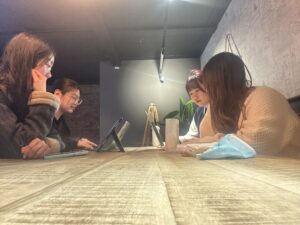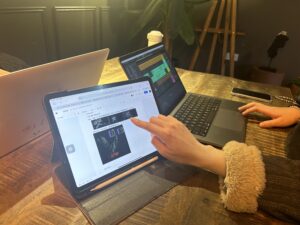Meeting Minutes: 05-02-2024
Attendees:
- Han Zou
- Yixuan Yang
- Xinxuan Zheng
- Jiayi Sun
Note-Taker: Han Zou


I. Decision Making
Before the meeting, each team member independently researched two potential project topics: Alzheimer’s Disease and Ocean Life ( Jellyfish). After reviewing the reference materials individually, the team collectively made a decision through a voting process. The consensus was to pursue the idea centered around Alzheimer’s Disease.
To facilitate later discussions, we recorded the web links of the materials gathered during the research in the shared document linked below. Additionally, we provided brief annotations highlighting key points for each material.
Within the document, Xinxua took the initiative to craft summaries and outline her initial thoughts on the project’s specific implementation. These summaries and thoughts served as focal points for our discussion during the meeting, providing a foundation for further exploration of the chosen project direction.
II. Outline of the Project:
In the meeting, we discussed some relatively detailed practical methods based on the content of the shared document. We decided to present a final installation divided into three main parts, and we write background story of the project as follows.
A woman, once vibrant and full of life, was diagnosed with Alzheimer’s disease at the age of 60. In the initial stage of Alzheimer’s, her grasp on the world slowly started slipping away. Details faded, and the once-familiar surroundings became a puzzle of forgotten images. She struggled to recall where she was, and the clarity of her understanding began to blur. As the disease progressed into its second stage, the people she held closest to her heart became strangers. Even the faces of her dearest family members eluded recognition, and her memories intertwined into a complex and bewildering tapestry. In the third and most challenging stage, her memory changed like wind, unpredictable and fleeting. Moments that once formed the fabric of her identity seemed on the verge of vanishing at any given time.
Part1: Vague
Concept explanation:
In portraying the early stage of blurred memory in Alzheimer’s patients, the visual part will use of a mosaic or fluid effect. The mosaic or scattered fragments, reflects the initial stages of cognitive deterioration.
Implementation method:
First, through ChatGPT, improve the settings of the protagonist in the overview and generate some stories (text). According to the story, use DALL-E, Mid-Journey, etc. to generate some images that match the background of the story. Then use Touchdesinger to create fluid effects on text or images and export video files. Finally involves sound design to complete this part, and connect all of them to the screen for playback.
Feasibility:
There are TouchDesinger tutorial resources available on the Internet to help us achieve fluid or mosaic effects. Moreover, because the main purpose of this part is to tell the story, the text or image is finally linear presented on the screen in 2D, and the hardware requirements are general, so the feasibility is relatively high at present.
Part2: Chaotic
Concept explanation:
Through ML, different faces are combined together, and AI is used to generate videos creating a gradually changing effect between different faces, aiming to portray the disorientation and confusion associated with memory impairment.
Implementation method:
There is an interaction in this part of the plan: a person stands in front of the camera and moves left and right to control the movement of video time nodes. The video is projected on the screen, and the faces displayed on the screen gradually change. Face materials are generated through AI and ML, and then AI is used to generate effects that slowly change between different faces (about 3-4 pictures are planned). Then use Max or Touch Designer to recognize some movement through camera and control the exact displaying frame in the video and the sound effects.
Feasibility:
The ML/AI tool for generating faces is available, and one of our team members have production experience in this area. When it comes to the equipment, the key device in this part is the camera which can be a normal built-in computer camera. Besides, Vizzie objects can be used in Max for image processing, and TD might have some similar function.
Part3: Vanish
Concept explanation:
Through TouchDesigner’s particle effects and audience interaction via waving, a 3D-scanned digital model is depicted dissipating like particles blown away by the wind. This simulation aims to mirror the gradual disappearance of memories in patients‘ brains.
Implementation method:
Begin by selecting a model and utilizing a mobile phone (or better equipment if available) to make a full-body 3D scan. Import the resulting 3D model into TouchDesigner to craft particle visual effects. For interaction, incorporate Kinect to recognize audience waving movements, thus controlling the playback of visual effects in TouchDesigner along with pre-made sound effects.
Feasibility:
One of our team members has previously experimented with the particle effects of the 2D model in TD, as well as the images presented by 3D scanning on the mobile phone. In terms of hardware, Kinect can be borrowed from the Music Store.
Note: The presentation of this section is not yet completely confirmed. Current plans are presented via projection or screen. But if equipment conditions permit, we hope to achieve the effect of holographic projection.
III. Sound / Music
During the initial meeting discussion, the team proposed a concept: as visitors navigate different areas of the installation, they wear headphones to experience corresponding sound feedback along with visual effects. However, recognizing the continuity of the memory forgetting theme, our sound designer opposed that individual headphone use might split the experience. To address this, she suggested a rough idea. Music will play in the background, as a bed, and the display room should equipped with multiple speakers playing the music bed. Additionally, three small speakers beneath each part’s screen would serve as audio objects and play feedback sound or some interactive effects when visitors reach specific areas. This holistic approach aims to maintain a cohesive experience throughout the evolving narrative.
The Sound Designer has created a demo to illustrate the desired music style, primarily featuring piano sounds. During the meeting, team members suggested expanding on this concept by incorporating different instruments for each part, adding diverse sound elements. Further refinement is planned in subsequent discussions.
In addition, regarding the vocal chop (demo shown below) effect that was planned to be used on the audio during last week’s discussion, it was temporarily shelved due to the difficulty in obtaining audio material, which is a recording of an Alzheimer’s patient telling a story.
IV. Roles and Responsibilities
In this meeting, we clarified the division of roles and responsibilities.
- Yixuan Yang:Part 1 and Part 3 visual and installation
- Xinxuan Zheng:Part 2 visual
- Jiayi Sun:Part 1 and Part 3 visual and installation
- Han Zou: Sound Design

